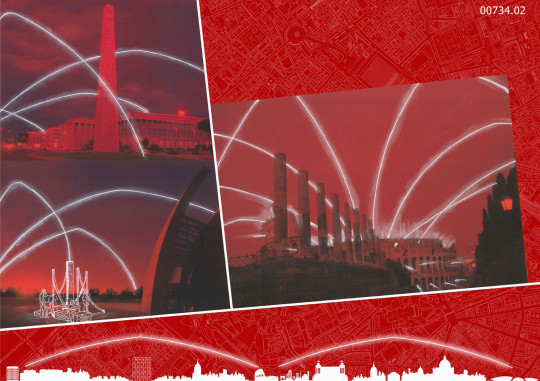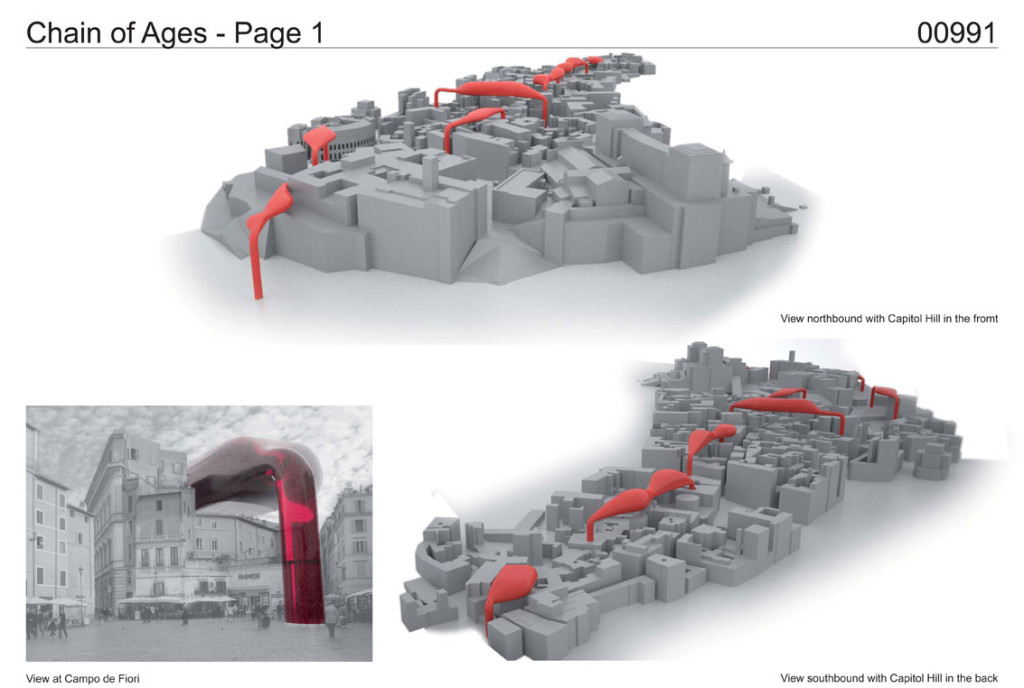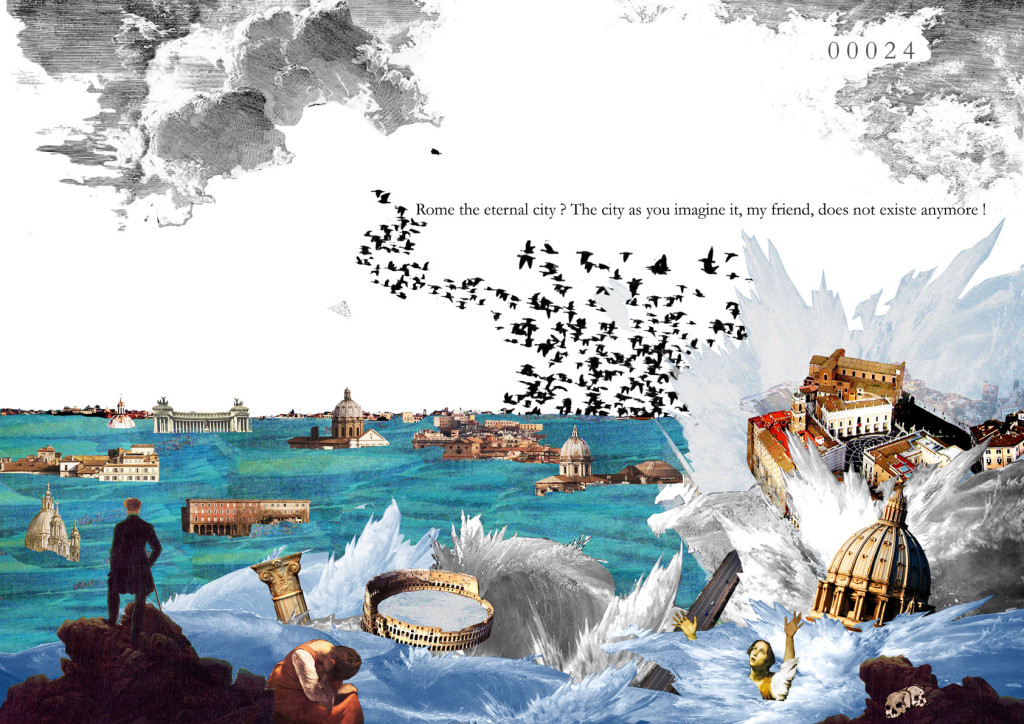Info:
Title: Looking - Code: 00734Contest: Rome / 2010
By: E. Del Vecchio / C. Di Giorgio
Views: 3260 Likes: 0
Votes:
JUERGEN MAYER H. 0 FRANCESCO LIPARI5 FELIPE ESCUDERO2 FRANCESCO GATTI 6 MICHAEL CATON 63.8
Looking


Looking at an old picture, an old movie, identifying places and realities and in a moment seeing them in a present time that doesn’t really do justice to people and places.
Walking about theEternalCityand finding out unknown and unexpected faces: closing the eyes and thinking about it, dreaming of the ”Bella vita” places, opening the eyes and recognizing a differentRome, a city ready to be lived and discovered.
Listening to debates that putRome in the middle of controversies, because of its endless problems, its contradictions due to difficult urbanistic, social and building features.
The historical city, which lives on its famous monuments and gathering places, doesn’t manage to be appreciated in the right way and in all its aspects, a city which is afraid of growing up, still anchored to its ”forma urbis” that anyway represents its distinctive character which makes it unique in the world.
The contemporary city, sometime relegated to the outskirts hidden in their shadows, in their insecurity of being incomplete and lacking in efficient infrastructure, in their discomfort of being second in renovation, areas to be enhanced for a better living, but however realities in their own right, the other City, the least known, denigrated because it is a ”outskirt”.
Touching every day issues that involve the entire city. Travelling from one district to another, from the periphery to the center and vice versa, clashing with the different dynamics that animate and characterize it.
Relishing smells and tastes ofRome, energetic by day, lively by night, aRome that is trying to evolve and grow the ”new city” within the ”old city”, just to become and European city.
The aim of many studies and research is to widen the outlook of the city, acknowledging and appreciating its many features through the reconstruction of a neighbourhood identity. So Rome becames a city to be consolidated, recovered, transformed, redesigned on new functionality requirements, not only urban but also social.
Romeis indeed a polycentric city, a metropolitan city not only for its extension but also because it is the crossroads of various cultures that enliven every corner. It is true that the increase in construction activity didn’t keep pace with the creation of an urban culture and often the disorganized development of the city tissue affected the readability of different places, but it is also true that many elements must be enhanced, whether architectural emergency or interesting places in terms of urban and social development.
It’s so that the project was born, a purely sensorial and ideological experience which aims to accompany, with simple distinctive signs, a difficult journey undertaken in the capital, in order to reduce physical and social distances and produce architectures that facilitate relations between different social and cultural classes.
Not only a monument, a place or a few districts as a symbol but all the city must be involved in this evolution.
In 1966 Pasolini said through his literary characters: ”My country’s name is Ideology, I come from the capital city, the city of the future”.
So we seeRome: a city that looks to the future, ideally approaching the city of the past (the Eternal city) to the contemporary city and vice versa, so that everyone knows that theRometo visit and to know is not only the one of the Coliseum.
So, it is the Colosseum, the ideal center of the ancient city, which becomes the focus of a project that does not pretend to solve the endless problems of Rome today, highlighting one of the many historical monuments or revitalizing with targeted and a few isolated gestures some suburbs, but wants to put a more general goal, leading to make perceptible the greatness and grandeur of Rome, a from any urban area.
The feeling of an area that extends in different shapes and fabrics, beyond the situation that we live in a sudden moment takes shape through light trails in the sky that trace arcs pointing toward reality belonging to the same city, even though they have different features.
That’s why the choice of a night perception is not accidental. Look up and turn away from the daily speed and noises, projecting into another place through light bridges that cross the city.
The three important elements in this project are:
Architecture and light: couple of great value, the light that makes the most of the historical patrimony, which gives comfort making life’s quality better and leads the way and the sight.
The Arc as a passage, an archaic principle to propose with a new look. The Arc no more seen as a carrying element or a monument … it is our strong track signed in the sky that wants to unite symbolically the poles of the city giving important landmarks.
Through the interaction of opposites such as nature and artifice, weight and lightness, shade and light, we suggest alternative routes, that highlight the other side ofRome, the aspect of a city that keeps on living beyond the historical city.
Constant accessibility of a landmark, which becomes a “heart of light” permeable to any person crossing the city.
So, bridges of light, that unite the heart of Rome with some representative districts of the contemporary city, each one with its own symbols, with their fabrics, with their distinctive features (Eur, Corviale, Foro Italico, the Flaminio area and the Parco della Musica, Monte Sacro with the Garden City, Tor Tre Teste with Meier’s Church, Tor Vergata and the future City of swimming).
Areas where first appeared the signs of modernity, sometimes not shared and often ignored because “distant”, areas sometime hard to reach, that’s why the virtual bridges turn the observer towards a distant goal in a few seconds.
All that would determine a real theater of light in the sky of the Capital, where leading characters are bundles of optical fibers, starting from a common light source (a central station consisting in a cylindrical element), arrive at outlying stations, with their terminal, providing real luminescent arches visible from every corner of the town.
Let’s show the advantages of fiber optics: instead of the electric current, a laser light flows inside them, in the form of electromagnetic waves, so they do not produce heat and these materials are really performant in the transmission of data. Moreover they are made of transparent flexible wires, so we indeed believe that the impact of all these factors onRomeduring the day, despite covering large distances, is not unpleasant.
So optical fibers have the function of canalizing the light flux radiated from the common light source and they would constitute a real “information highway” whose purpose is the communication among different stations, located within the Flavian Amphitheatre (CPU) and at arrival points of light beams (peripheral stations).
These stations are designed as structures where the drive units (cylinders containing the light source, terminals and projectors) are surrounded by wings made of lightweight structures such as play and transparent holographic projections touch screen.
They become so pieces of furniture for the city, but especially interactive information points explaining, at night, the city (through itineraries and suggestions for mobility) and the function of the arches themselves
Here is the project’s purpose and the meaning of these artificial rainbows: to write guides for a new and different reading of the city and to compare different situations and environments
As we read recently … “There can be no progress without facing the unknown”.






